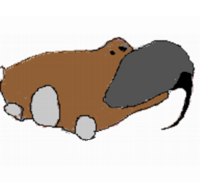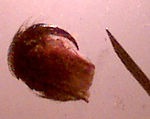Chelicerae
The Chelicerae (pronounced /kəˈlɪsəˌri/) are mouth parts of the Chelicerata, an arthropod subphylum that includes arachnids, Merostomata (horseshoe crabs), and Pycnogonida (sea spiders). Chelicerae are pointed appendages which are used to grasp food, and are found in place of the chewing mandibles most other arthropods have. Additionally, some chelicerae, such as those found in spiders, are hollow and contain (or are connected to) venom glands, and are used to inject venom into prey or a (perceived) threat.
Contents |
Types of chelicera
The chelicerae can be divided in three kinds: jackknife chelicera (green in the image to the right), scissor chelicera (blue) and 3-segmented chelate chelicerae (red).
Jacknife chelicera
The jacknife chelicera is subchelate (with fixed finger much reduced or absent) and is composed of two segments. This type of chelicera occurs exclusively in the Tetrapulmonata.
Jacknife chelicera presents two different forms: orthognathous and labidognathous. The orthognathous chelicera is articulated in a manner that enables movements of the appendages parallel to the body axis. This kind of chelicera occurs in the Liphistiomorphae and Mygalomorphae spiders and in the related orders Amblypygi, Schizomida, Thelyphonida. The labidognathous chelicera moves at right angles to the body axis. This kind of chelicera is rotated and occurs exclusively in the Araneomorphae spiders.
Spider chelicerae

The chelicerae consist of a base segment that articulates with the cephalothorax and a fang portion that articulates with the base segment. An analogy for this is a two-segment finger, the outer segment of which consists of a hollow fang. Except for a few small families of spiders, all spiders have venom that is injected into their prey through openings in the tips of their fangs when a spider bites something. The glands that produce this venom are located in the two segments of the chelicerae, and, in most spiders, extend beyond the chelicerae and into the cephalothorax.
The fang, the organic functional equivalent to a hypodermic needle is what penetrates the skin, fur, or exoskeleton of the spider's target--spider mouthparts are primarily intended for envenoming a spider's prey in most species, typically insects and other small arthropods; not for biting humans. The basal portion includes all or part of the spider's venom glands, which can be squeezed under voluntary control by the spider to force venom out of the glands and into the wound.[1]

When a spider bites, the two parts of the chelicerae come together like a folding knife, and when making a threat display or actually preparing to bite, the spider will open the angle of the fangs with the basal portion of chelicerae and also open the angle of the basal portion with the cephalothorax. In the tarantulas and other Mygalomorphae, the horizontal separation of the tips of the fangs does not change much, but in the other spiders the tips of the fangs move apart from each other as well as elevating. Even the tips of the fangs of the rather large spider shown above are quite sharp, and the spider's body is well adapted to driving the fangs into flesh. Some spider bites, such as those of the Sydney funnel-web spider, are reported to have penetrated toe nails and soft leather shoes.

The fang of this immature Psalmopoeus cambridgei spider is about 2mm long. The spider herself is about 25mm long
|

10x microphotograph of the chelicera and the tip of the smallest sewing needle available in ordinary commerce
|

10x microphotograph of the same Psalmopoeus cambridgei spider and the tip of a 22 gauge (0.025") hypodermic needle.
|
Scissor chelicera
The scissor chelicera is chelate and composed of two segments and occurs in the orders Pseudoscorpiones and Solifugae.
3-segmented chelate chelicerae
This is the primitive condition and occurs in arachnids such as the Scorpiones and the Opiliones. It also occurs in non-arachnid Chelicerata such as the Xiphosura and Eurypterida. Arguably the chelifores of the Pycnogonida are homologous to the chelicerae and should be included in this count.
References
- ↑ Foelix, Rainer F. (1996). Biology of Spiders (2nd edition). Oxford University Press. ISBN ISBN 0-19-509594-4.